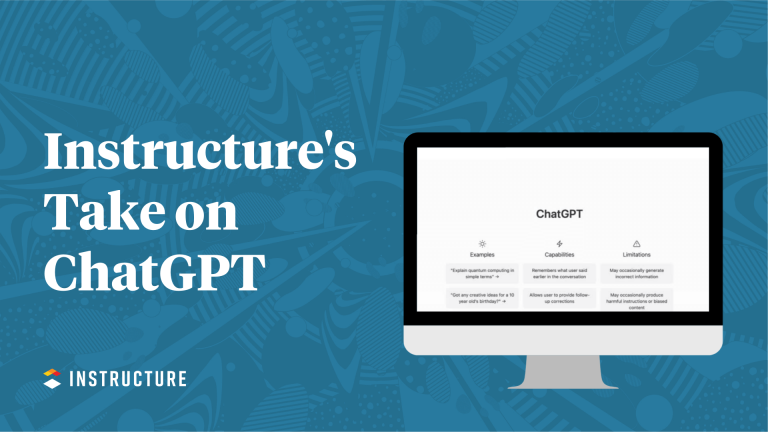
As we have all noticed, AI tools such as ChatGPT have arrived in global learning. In fact, they have been here a while, but their most immediate and present use has been illuminated by the loud arrival of ChatGPT (and Google’s Bard in real-time). Since the new year, many of you have asked, “What does Instructure think about ChatGPT?” We have been thinking about this complex topic a lot. Here is our take:
In short, ChatGPT has the potential to revolutionize the way we approach education by providing an intuitive and interactive platform for students and educators to engage in learning. With its advanced natural language processing capabilities, ChatGPT can help students understand and retain complex concepts, as well as provide personalized feedback and support. Additionally, its ability to generate human-like text can also be used to create engaging educational content, such as interactive stories and simulations. Overall, ChatGPT is a powerful tool that can enhance the learning experience for students and make education more accessible and effective. This makes it so much more than the cheating tool that is getting much of the recent press.
Across Instructure, we are actively investigating ChatGPT’s potential as a tool to improve teaching and learning. More broadly, we see AI technology as a tool students will use throughout their life-long learning journey. In this vein, we believe:
- Simply blocking ChatGPT won’t work. Blocking the tool on school-owned devices will not prevent students from accessing it on their own phones, laptops, etc. And while ChatGPT is the first tool of its kind, it’s simply the first of many to come. Trying to block them all would be a time-consuming and distracting exercise.
- AI can be a valuable tool for educators. As outlined above, embraced appropriately by educators, AI tools can be an effective support in delivering a personalized learning experience for students while saving educators time.
- We need to find better ways to measure mastery of content/skills. Our education mission should be to help all students understand and value the importance of the skills they’re developing throughout their learning journey. Part of that mission is to develop better ways of measuring student mastery as they progress. AI tools such as ChatGPT can potentially play a role in this process as students learn how to make meaning of information and connect ideas. Gone are the days when students could simply write a book report or a brief essay to demonstrate mastery of a subject.
- Like it or not, AI is the future. AI technology is already available today that enables people with little to no knowledge of code to write software and develop apps. These tools are capable of generating marketing content, populating legal applications, and enabling non-designers to create artwork that meets their needs. These tools will only become more advanced and ubiquitous in the near future. Let’s prepare the future workforce together.
As you can see, we are unpacking ChatGPT and AI opportunities across multiple spectrums, including within our own systems. We plan to address many more of the implications of this technology in the coming months, so stay tuned!
Related Content
 Teaching-With-Tech-10-Benefits.jpg
Teaching-With-Tech-10-Benefits.jpgBlogs
 cidilabs.png
cidilabs.pngBlogs
 canvas_x_tg_logo_lockup_780_x_520.png
canvas_x_tg_logo_lockup_780_x_520.pngBlogs
